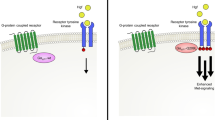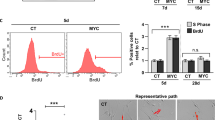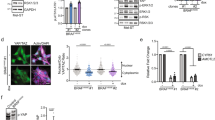Abstract
The MGSA/GRO protein is endogenously expressed in almost 70% of the melanoma cell lines and tumors, but not in normal melanocytes. We have previously demonstrated that over-expression of human MGSA/GROα, β or γ in immortalized murine melanocytes (melan-a cells) enables these cells to form tumors in SCID and nude mice. To examine the possibility that the MGSA/GRO effect on melanocyte transformation requires expression of other genes, differential display was performed. One of the mRNA's identified in the screen as overexpressed in MGSA/GRO transformed melan-a clones was the newly described M-Ras or R-Ras3 gene, a member of the Ras gene superfamily. Over-expression of MGSA/GRO upregulates M-Ras expression at both the mRNA and protein levels, and this induction requires an intact glutamine-leucine-arginine (ELR)-motif in the MGSA/GRO protein. Western blot examination of Ras expression revealed that K- and N-Ras proteins are also elevated in MGSA/GRO-expressing melan-a clones, leading to an overall increase in the amount of activated Ras. MGSA/GRO-expressing melan-a clones exhibited enhanced AP-1 activity. The effects of MGSA/GRO on AP-1 activation could be mimicked by over-expression of wild-type M-Ras or a constitutively activated M-Ras mutant in control melan-a cells as monitored by an AP-1-luciferase reporter, while expression of a dominant negative M-Ras blocked AP-1-luciferase activity in MGSA/GRO-transformed melan-a clones. In the in vitro transformation assay, over-expression of M-Ras mimicked the effects of MGSA/GRO by inducing cellular transformation in control melan-a cells, while over-expression of dominant negative M-Ras in MGSA/GROα-expressing melan-a-6 cells blocked transformation. These data suggest that MGSA/GRO-mediated transformation requires Ras activation in melanocytes.
This is a preview of subscription content, access via your institution
Access options
Subscribe to this journal
Receive 50 print issues and online access
$259.00 per year
only $5.18 per issue
Buy this article
- Purchase on Springer Link
- Instant access to full article PDF
Prices may be subject to local taxes which are calculated during checkout






Similar content being viewed by others
Abbreviations
- CXC chemokine:
-
chemokine with the first two conserved cysteine residues separated by an intervening amino acid
- CMV:
-
cytomegalovirus
- DMEM:
-
Dulbecco's modified Eagle's medium
- IL-8:
-
interleukin-8
- MGSA/GRO:
-
melanoma growth-stimulatory activity/growth-regulated protein
- AP-1:
-
activation protein-1
- RT-PCR:
-
reverse transcription-polymerase chain reaction
- SV-40:
-
simian virus-40
- EMSA:
-
electrophoresis mobility shift assay
- and MMLV:
-
moloney murine virus
- ELR motif:
-
glutamine-leucine-arginine tripeptide sequence near the N-terminus of MGSA/GRO proteins
References
Arenberg DA, Polverini PJ, Kunkel S, Shanafelt A, Hesselgesser J, Horuk R and Strieter M. . 1997 J. Leukocyte Biol. 62: 554–562.
Balentien E, Mufson BE, Shattuck RL, Derynck R and Richmond A. . 1991 Oncogene 6: 1115–1124.
Bennett DC, Cooper PJ and Hart IR. . 1987 Int. J. Cancer 39: 414–418.
Cao Y, Chen C, Weatherbee JA, Tsang M and Folkman J. . 1995 J. Exp. Med. 182: 2069–2077.
Chin L, Tam A, Pomerantz J, Wong M, Holash J, Bardeesy N, Shen Q, O'Hagan R, Pantginis J, Zhou H, Horner JW, Cordon-Cardo C, Yancopoulos GD and DePinho RA. . 1999 Nature 400: 468–472.
Della Rocca GJ, van Biesen T, Daaka Y, Luttrell DK, Luttrell LM and Lefkowitz RJ. . 1997 J. Biol. Chem. 272: 19125–19132.
Domann FE Jr, Levy JP, Finch JS and Bowden GT. . 1994 Mol. Carcinog. 9: 61–66.
Fujimoto J, Ichigo S, Hori M, Morishita S and Tamaya T. . 1995 Mol. Biol. 55: 25–33.
Geiser T, Dewald B, Ehrengruber MU, Clark-Lewis I and Baggiolini M. . 1993 J. Biol. Chem. 268: 15419–15424.
George DL, Glick B, Trusko S and Freeman N. . 1986 Proc. Natl. Acad. Sci. USA 83: 1651–1655.
Haghnegahdar H, Du J, Wang D, Strieter RM, Burdick MD, Nanney LB, Cardwell N, Luan J, Shattuck-Brandt R and Richmond A. . 2000 J. Leuk. Biol. 67: 53–62.
Haskill S, Peace A, Morris J, Sporn SA, Anisowicz A, Lee SW, Smith T, Martin G, Ralph P and Sager R. . 1990 Proc. Natl. Acad. Sci. USA 87: 7732–7736.
Hawes BE, Luttrell LM, van Biesen T and Lefkowitz RJ. . 1996 J. Biol. Chem. 271: 12133–12136.
Hébert CA, Vitangcol RV and Baker JB. . 1991 J. Biol. Chem. 266: 18989–18994.
Hesselgesser J, Chitnis CE, Miller LH, Yansura DG, Simmons LC, Fairbrother WJ, Kotts C, Wirth C, Gillece-Castro BL and Horuk R. . 1995 J. Biol. Chem. 270: 11472–11476.
Huang HS, Nagane M, Klingbeil CK, Lin H, Nishikawa R, Ji XD, Huang CM, Gill GN, Wiley HS and Cavenee WK. . 1997 J. Biol. Chem. 272: 2927–2935.
Husain Z, Yang QM and Biswas D. . 1990 Arch. Dermatol. 126: 324–330.
Iida N and Grotendorst GR. . 1990 Mol. Cell. Biol. 10: 5596–5599.
Johnson R, Spiegelman BM, Hanahan D and Wisdom R. . 1996 Mol. Cell. Biol. 18: 4504–4511.
Kimmelman A, Tolkacheva T, Lorenzi MV, Osada M and Chan AM. . 1997 Oncogene 15: 2675–2685.
Knall C, Worthen GS and Johnson GL. . 1997 Proc. Natl. Acad. Sci. USA 94: 3052–3057.
Kolibaba KS and Druker BJ. . 1997 Biochim. Biophys. Acta. 1333: F217–F248.
Kurdowska A, Cohen AB, Carr FK, Stevens MD, Miller EJ, Mullenbach G and Tekamp-Olson P. . 1994 Cytokine 6: 124–134.
Limatola C, Mileo AM, Giovannelli A, Vacca F, Ciotti MT, Mercanti D, Santoni A and Eusebi F. . 1999 J. Biol. Chem. 274: 36537–36543.
Lloyd AC, Yancheva N and Wasylyk B. . 1991 Nature 352: 635–638.
Lopez-Ilasaca M, Crespo P, Pellici PG, Gutkind JS and Wetzker R. . 1997 Science 275: 394–397.
Louahed J, Grasso L, De Smet C, Van Roost E, Wildmann C, Nicolaides NC, Levitt RC and Renauld JC. . 1999 Blood 94: 1701–1710.
Luan J, Shattuck-Brandt R, Haghnegahdar H, Owen JD, Strieter R, Burdick M, Nirodi C, Beauchamp D, Johnson KN and Richmond A. . 1997 J. Leuk. Biol. 62: 588–597.
Mangues R, Seidman I, Gordon JW and Pellicer A. . 1992 Oncogene 7: 2073–2076.
Matsumoto K, Asano T and Endo T. . 1997 Oncogene 15: 2409–2417.
Mattei S, Colombo MP, Melani C, Silvani A, Parmiani G and Herlyn M. . 1994 Int. J. Cancer 56: 853–857.
McKay IA, Marshall CJ, Cales C and Hall A. . 1986 EMBO J. 5: 2617–2621.
Neptune ER and Bourne HR. . 1997 Proc. Natl. Acad. Sci. USA 94: 14489–14494.
Owen JD, Strieter R, Burdick M, Haghnegahdar H, Nanney L, Shattuck-Brandt R and Richmond A. . 1997 Int. J. Cancer 73: 94–103.
Quilliam LA, Castro AF, Rogers-Graham KS, Martin CB, Der CJ and Bi C. . 1999 J. Biol. Chem. 274: 23850–23857.
Rennekampff HO, Hansbrough JF, Woods V, Jr; Dore C, Kiessig V and Schroder JM. . 1997 Arch. Dermatol. Res. 289: 204–212.
Richmond A and Thomas HG. . 1986 J. Cell. Physiol. 129: 375–384.
Richmond A and Thomas HG. . 1988 J. Cell. Biochem. 36: 185–198.
Rodeck U, Becker D and Herlyn M. . 1991 Cancer Cells 3: 308–311.
Rosenkilde MM and Schwartz TW. . 2000 Mol. Pharmacol. 57: 602–609.
Rutberg SE, Lee EJ, Hansen LH, Glick AB and Yuspa SH. . 1997 Mol. Carcinog. 20: 88–98.
Sadhu C, Masinovsky B and Staunton DE. . 1998 J. Immunol. 160: 5622–5628.
Saez E, Rutberg SE and Mueller E. . 1995 Cell 82: 721–732.
Shattuck RL, Wood LD, Jaffe GJ and Richmond A. . 1994 Mol. Cell. Biol. 14: 791–802.
Shattuck-Brandt RL, Wood LD and Richmond A. . 1997 DNA Sequence 7: 379–386.
Shattuck-Brandt RL and Richmond A. . 1997 Cancer Res. 57: 3032–3039.
Shyamala V and Khoja H. . 1998 Biochemistry 37: 15918–15924.
Smith JJ, Derynck R and Korc M. . 1987 Proc. Natl. Acad. Sci. USA 84: 7567–7570.
Taylor SJ and Shalloway D. . 1996 Curr. Biol. 6: 1621–1627.
van Dam H, Huguier S, Kooistra K, Baguet J, Vial E, Vandereb AJ, Herrlich P, Angel P and Castellazzi M. . 1998 Genes Dev. 12: 1227–1239.
Vojtek AB and Der CJ. . 1998 J. Biol. Chem. 273: 19925–19928.
Westaway D, Papkoff J, Moscovici C and Varmus HE. . 1986 EMBO. J. 5: 301–309.
Winzen R, Kracht M, Ritter B, Wilhelm A, Chen C-YA, Shyu A-B, Muller M, Gaestel M, Resch K and Holtmann H. . 1999 EMBO J. 18: 4969–4980.
Wood LD and Richmond A. . 1995 J. Biol. Chem. 270: 30619–30626.
Zhang B, Shih JW, Wear DJ, Tsai S and Lo SC. . 1997 Proc. Sco. Exp. Biol. Med 214: 359–366.
Yang W, Wang D and Richmond A. . 1999 J. Biol. Chem. 274: 11328–11333.
Acknowledgements
We are indebted to the NIH for support: CA56704 (A Richmond); Vanderbilt Cancer Center CA 68485, Department of Veterans Affairs Merit Award and Career Scientist Award (A Richmond), and to James Owen and Eddy Balentien for developing the MGSA/GRO expressing melan-a clones. We are also indebted to Ben Johnston and Amy Pruitt for excellent technical assistance.
Author information
Authors and Affiliations
Rights and permissions
About this article
Cite this article
Wang, D., Yang, W., Du, J. et al. MGSA/GRO-mediated melanocyte transformation involves induction of Ras expression. Oncogene 19, 4647–4659 (2000). https://doi.org/10.1038/sj.onc.1203820
Received:
Revised:
Accepted:
Published:
Issue Date:
DOI: https://doi.org/10.1038/sj.onc.1203820
Keywords
This article is cited by
-
Network-pharmacology-based validation of TAMS/CXCL-1 as key mediator of XIAOPI formula preventing breast cancer development and metastasis
Scientific Reports (2017)
-
Signature of cytokines and angiogenic factors (CAFs) defines a clinically distinct subgroup of gastric cancer
Gastric Cancer (2017)
-
Gene-expression analysis of a colorectal cancer-specific discriminatory transcript set on formalin-fixed, paraffin-embedded (FFPE) tissue samples
Diagnostic Pathology (2015)
-
Clinical significance of serum expression of GROβ in hepatocellular carcinoma
Tumor Biology (2015)
-
New susceptibility locus for obesity and dyslipidaemia on chromosome 3q22.3
Human Genomics (2013)



